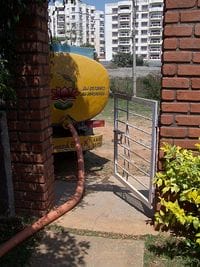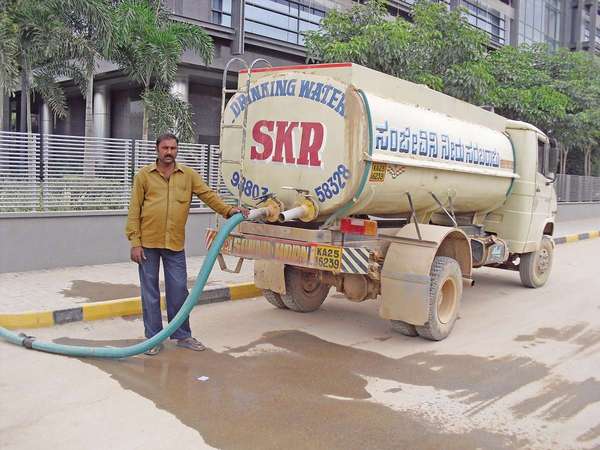Love them or hate them, apartment residents cannot survive without them. Pic: Sankar C G
Most Management Committee members of apartment complexes in Bengaluru are familiar with water problems — many of them find themselves in an unenviable tight corner between water tanker vendors and demanding residents!.
Who are these water vendors?
For a scholarly understanding of ‘water tanker mafia’, see this article.
It would seem that vendors are a privileged set of a few who have nearly unlimited access to the most exploited resource in the city – ground water, and have made a livelihood/business out of it. In our neighbourhood, they are mostly land-owners in and around Bellandur. There are a number of borewells around the very polluted Bellandur lake, as well as other lakes like Iblur, Kaikondrahalli, Agara etc. There are also borewells on assorted private and public lands including cemeteries.
 We are told borewells have water at a depth of 800 feet or lower. The last few years have seen the water table go further down, and there are stories of bore wells dug 1000 feet deep or more.
We are told borewells have water at a depth of 800 feet or lower. The last few years have seen the water table go further down, and there are stories of bore wells dug 1000 feet deep or more.
Assuming 10,000 flats in a neighbourhood, the requirement is 5 Million litres per day, at conservative 250 litres per day per family. And new apartment projects are sprouting up every day.
Apartment committees’ nightmare!
All our apartments are dependent almost completely on tanker water supplies. It doesn’t look like there are any immediate plans for BWSSB to supply water to our neighbourhood. Many builders have not paid BWSSB the deposits they collected. Groundwater levels are scarily low. There are many steps apartments are adopting – some as ruled by the government, some voluntarily – from Rainwater Harvesting, ground water recharge, reusing treated water for gardening and flushing, installing low-flow aerators etc.
In spite of all this, Management Committees will have to continue dealing with tanker vendors in the near future. The challenges include:
- Vendors are very temperamental. Written contracts do not work, only personal good relations do.
- They become unreachable just when your reserves are running low.
- Break in supply due to higher demand in summer.
- False commitments making it difficult for MCs to plan.
- Turf war between vendors.
- Staying up late to ensure water supply happens during emergencies!
- Some vendors refuse to cut supply during monsoon when demand is lower – they insist on the usual volume being bought.
Beaten from both sides!
Meanwhile, it is not easy being at the receiving end of brick bats from the residents: they have high expectations, and compare supply quality with neighbouring apartments, some even have incomprehensible requests (“Can one tanker be supplied separately to our flat alone because we have six guests today?”).
There are residents who hoard water in small tanks/drums inside their apartment to beat water rationing by the MC.
Things somehow seem to ease out when June begins, whether El Nino or not. And in January, water supply slowly reduces! There are usually some indications in January that something’s cooking before summer. That’s because — It is rate revision time!
Making money when the sun shines!
Water vendors try to make money while water lasts – because their borewells often run dry, power cuts happen, motors go kaput, vehicles breakdown, and they face spiralling fuel cost. Drivers take off on a break without notice, they drive when drunk, or fall sick or get into accidents. They do not have storage infrastructure to plan their supply better. Come summer, the matter only gets worse.
Can borewells sustain at this rate? Can we depend on only water tankers as our source of water? What is the way out? If you are a Managing Committee member dealing with water matters, do comment below with your thoughts!
Related Articles
Water tankers rule, no one to question
Tanker water prices up, apartments in distress

What is the cost per load of water from these tankers now?
We used to pay around Rs. 350 for a 6KL load before Cauvery turned up mid last year. The CMC borewell had gone try and these tankers were the only option. They used to be around at all times of the day and night – even at 11:30 the diesel engines would be rumbling and there were even tractors rolling around the quiet layout. To cross a section of road, we had to line up at one side and commit to the road only if line-of-sight to the other end was available. Most of the time they’d take up the whole road and not budge. You take panga, you might not get water next time. So glad to be rid of them. (touchwood, at least for now)
We’d soon be trying to crowdsource water price for tankers in various areas and map it.
‘@vaidya, we gathered some data on tanker rates at the Water Workshop for apartment complexes in June. You can check the rates for tanker water across the city here: http://bangalore.citizenmatters.in/articles/water-tanker-price-map-bangalore
Govt needs to come forward to regulate water tankers, price, parking etc… These water tankers generally are parked in residential areas, covering whole narrow street. They do full commercial activities in residential areas which makes lots of inconvenience to public.
I think the eventual solution is going to be to pressurize either BWSSB or BBMP to supply piped water using borewells. Cauvery water is never going to be enough for all of Bangalore’s entire needs. In Coimbatore and elsewhere in the Noyyal river basin, we see a dual-supply system: the TMC or Corporation supplies ‘sweet river water’ once a week, and through the same pipeline (or sometimes parallel pipeline) it supplies borewell water 3 times a week. People store the sweet water drinking and cooking, and use the borewell water for other needs. Thus, the urban local body is meeting all your basic requirements and then it has a stake in managing groundwater as well. The Bangalore situation where BWSSB ignores groundwater, and sets up an “all Cauvery or nothing” system of supply, is not fair nor sustainable.